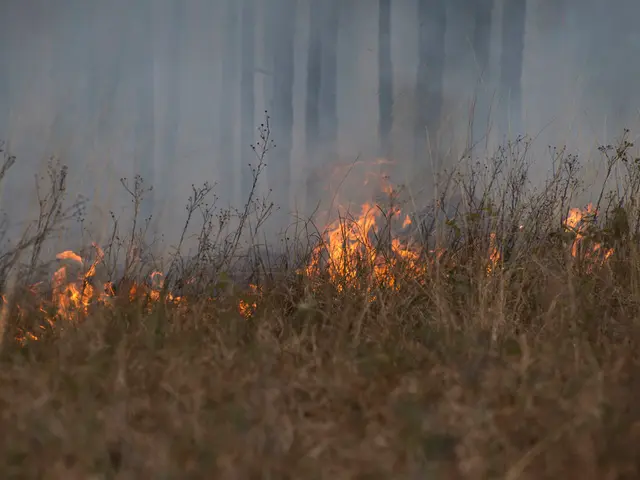Regional Chaos in the Middle East: Exploring Continuing Conflicts and Unrest
A Tumultuous Voyage Through Modern Middle Eastern History
The Middle East, steeped in historical importance and geopolitical significance, has undergone seismic shifts since the ‘90s, altering the region's face and resonating globally. This whirlwind journey involves key events like the Arab Spring, ISIS's rise, and wars in Syria and Yemen. In this piece, we dive into the heart of these revolutionary epochs.
The Arab Spring: A Tsunami of Democratic Fervor
The Arab Spring, which crested in late 2010, holds monumental status in the Middle East's history. This series of protests, rebellions, and uprisings swept across the Arab world, emanating in Tunisia following Mohamed Bouazizi's self-immolation. As his act of desperation reverberated, it ignited a wave of unrest promising democratic change but frequently ending in prolonged strife and instability.
Egypt, Libya, and Yemen saw leaders ousted, while Syria's uprising escalated into a full-blown civil war. Although outcomes were diverse—Tunisia transitioned to democracy, Egypt's initial democratic gains were soon reversed—the legacy of strife was widespread. Libya and Yemen plunged into prolonged conflicts, illustrating the complexity of orchestrating change amid deep-seated political and social obstacles within the region.
The Rise of ISIS: A New Threat materializes
In the vacuum created by the Arab Spring, extremist groups found fertile ground. The most notorious was the Islamic State of Iraq and Syria (ISIS), which surfaced in 2014. Two years later, it declared a caliphate over vast areas of Iraq and Syria, it conducted a campaign of terror locally and globally and inspired orcoordinated terrorist attacks worldwide. Their brutal tactics like mass executions, abductions, and enslavement sparked international condemnation.
The rise of ISIS impacted the Middle East's geopolitical landscape, necessitating an international response involving a multifaceted array of actors, including the U.S., Russia, Iran, non-state actors, and traditional adversaries finding common ground against this shared menace. ISIS's territorial defeat in 2019 marked a milestone, but their ideology and decentralized operations persist as a security challenge.
Syria's Conflict: A Multidimensional War with Far-reaching Consequences
Syria's conflict, initiated in 2011 as part of the Arab Spring, transformed into one of the most intricate and devastating wars of the 21st century. The war pitted the Syrian regime, led by President Bashar al-Assad, against various opposition groups. The situation grew more convoluted with the involvement of external actors such as the U.S., Russia, Turkey, and Iran—each motivated by distinct interests and agendas.
The Syrian war has wrought staggering consequences on the country and its people, with hundreds of thousands of fatalities, millions of displaced people, and widespread devastation. Regionally, it has stirred strained relations, exerted pressure on neighboring countries, and fueled the rise of ISIS. Despite multiple attempts at peace talks and ceasefires, the conflict remains stalemated, with the Assad regime regaining control of most territory but regions like Idlib still under the opposition's sway.
Yemen's Unending Suffering
Yemen's conflict—often dubbed the world's worst humanitarian crisis—broke out in 2014 when Houthi rebels seized control of the capital, Sana'a, eventually ousting the internationally recognized government. The situation escalated in 2015 with the Saudi-led coalition intervening in support of the government. This internationalization of the conflict transformed a domestic power struggle into a devastating proxy war involving regional powers, notably Saudi Arabia and Iran.
Yemen's war has led to unparalleled human suffering, with thousands dead, millions displaced, and the majority of the population reliant on humanitarian assistance. The conflict has also wrought havoc on infrastructure and been marked by allegations of war crimes and human rights violations by all parties involved. Despite rounds of peace talks and international pressure for a ceasefire, the conflict remains in deadlock, deepening the humanitarian crisis and destabilizing the region.
The Impact on Regional Stability and International Relations
The Middle East's turmoil since the ‘90s has greatly influenced regional stability and international relations. The Arab Spring's mixed outcomes, ISIS's emergence and fall, and the prolonged conflicts in Syria and Yemen have reshaped power dynamics in the region. These events highlight the limitations of external intervention and the complexity of addressing deep-seated political, social, and sectarian strife.
Involvement of global powers like the U.S., Russia, and Europe, alongside regional players like Iran, Saudi Arabia, and Turkey, often reflects broader strategic interests, highlighting the global implications of Middle Eastern stability.
The Humanitarian Impact and Refugee Crisis
The upheavals in the Middle East have triggered a profound humanitarian crisis and refugee wave, particularly in Syria and Yemen. These conflicts have had significant social, economic, and political consequences for host countries and presented challenges to international refugee and asylum systems.
The Role of External Powers and Proxy Wars
The involvement of external powers in the Middle East, often aggravating conflicts, has turned domestic struggles into proxy wars. This is evident in Syria and Yemen, where the Assad regime's primary backers, Russia and Iran, have clashed against U.S.-supported Kurdish forces and various rebel groups. Similarly, Saudi Arabia and Iran find themselves on opposing sides in Yemen, reflecting broader Sunni-Shia divisions and geopolitical contentions.
The Economic Fallout and Reconstruction Challenges
The conflicts have left a heavy economic impact on the region, with countries like Syria and Yemen experiencing a massive economic downturn due to infrastructure destruction and a collapse of normal economic activity. Rebuilding these ravaged economies demands substantial international aid and investment.
The Evolving Nature of Terrorism
Although ISIS lost its territorial control, its ideology and the potential for future terrorist activities persist. The group has adopted insurgency tactics and continues to inspire lone-wolf attacks worldwide.
Looking Forward: Prospects for Peace and Stability
As tensions persist, the Middle East stands poised between pervasive turmoil and hope for a more secure and prosperous future. The future trajectory hinges on external and regional actors' commitment to diplomatic solutions, humanitarian aid, and reconstruction investments in war-torn areas. In addition, addressing the root causes of conflict, such as governance issues, economic disparities, and sectarian tensions, is critical for long-term peace and stability.
Conclusion
The Middle East's voyage since the ‘90s has been tumultuous, marked by aspirations for change, war, terrorism, and complex geopolitical entanglements. Fathoming the complexity of these issues is vital for policymakers and stakeholders who navigate the challenges and opportunities in this strategic region. While the road to peace and stability is arduous, with resolve and a focus on addressing underlying causes of conflict, there is optimism for a more stable and prosperous Middle East.
The Arab Spring not only highlighted the democratic fervor among the Middle Eastern populace but also underscored the complexity of orchestrating change amid deep-seated political and social obstacles within the region. (government, migration, war-and-conflicts)
The rise of ISIS and their brutal tactics like mass executions, abductions, and enslavement sparked international condemnation, refocusing global attention on crime-and-justice issues. (crime-and-justice, general-news)
The prolonged conflicts in Syria and Yemen have led to staggering human suffering, a profound humanitarian crisis, and a refugee wave. These events have tested the resilience of host countries and international refugee systems. (accidents, fires, humanitarian-issues, migration)
The role of external powers in proxy wars, such as the conflicts in Syria and Yemen, has permeated general-news discussions and sparked debates on politics, reflecting broader strategic interests that impact international relations. (politics, international-relations)








